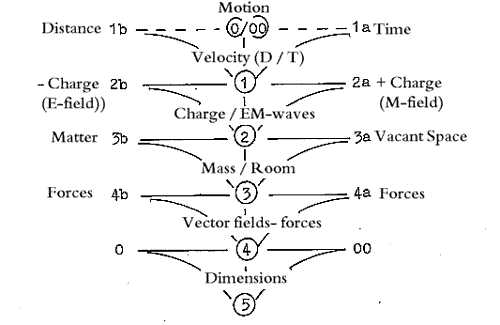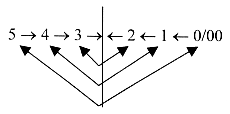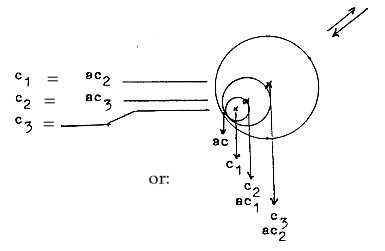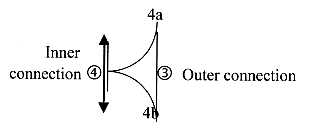|
Mass as property - once again ?
How is the property of Mass deduced from pure dimensions,
geometries and motions, according to our very elementary model
through steps 4 → 3 →
pole 3a (or 3b) ?
1. We have the views from earlier files that
- mass is a degree of complexity in structure,
- represents enclosed centers, in opposition to the excluded
center,
- is a property that (to a great extent - ?- or totally) lies
in binding energy,
- implies a step in the "substantiation" of lower
d-degrees towards higher levels,
- is closely related to Gravitation, regarded as a force,
a vector field,
- represents the dense "pole" of the physical quantity
Density when polarized,
and inward Direction, referring to our first identification
of physical quantities.
2. Mass from radiation or vector fields?
According to suggestions in our elementary model, mass should
be a property not defined as such before d-degree 3 is polarized
and mass constitutes one "pole" or partial structure
of d-degree 2 in relation to Vacant Space, d-degree 2 suggested
as representing the property Charge.
3b
---------2 ------------ 3a:
Hence, we should expect some close relation to the concept
of Charge already in the concept of Mass. And in terms of
fields also to the electromagnetic field (EM).

From the other point of view, from the 0/00-end of the dimension
chain, Mass could include 2 (or 2,5) d-degrees of motion built-in,
(of built-in Time if we want to express it that way), or of
"velocity" as a concept for d-degree steps.

Physicists want to think of the first Universe after Big
Bang as "radiation - obviously of EM-type, this then
in some way transformed to protons and electrons with mass.
According to our model, this should be only
half the history: Some kind of 3-dimensional structure out
of vector fields should be "meeting" in step 3-2
and included in the creation of matter with protons representing
most of the mass.
3. A Higgs' branch and a Coulomb branch:
In connection with the search for "Higgs particle"
in later years which should carry the Mass property, one meets
the words about "a Higgs' branch" and "a Coulomb
branch", as if the properties Mass and Charge was about
a ramification. In our model this should imply the perpendicular
reading of the dimension chain - as polarizations 5 →
4+1, 5→ 3+2:

(A little more about Higgs' particle below.)
4. From bosons as "superpositions" to fermions
with Mass:
The derivation of Mass from fields is in accordance with most
physicists' theories: mass as tied up vector fields, locked
kinetic energy or the like.
In our model Mass is assumed as a property
stepwise defined through 2-3 polarizations, i. e. through
d-degree steps 5→4→3→(3a
— 3b).
Bosons, the quanta of vector fields, usually described as
massless as the photon, can have any mass whatsoever according
to another formulation. We remember the interpretation of
"superpositions" in quantum mechanics. In our model
Mass is not yet defined in d-degree 4, first in d-degree step
3-2, as a certain quality of the energy, a certain structure
in our view here. It's possible then to see the bosons as
superpositions, representing higher d-degrees, the level where
the outcome may be "mass - no mass" in lower degree.
In our first postulates we have assumed
the definition that higher d-degrees represent the binding
force in relation to next lower degree. This seems illustrated
in the relation bosons -- mass particles (fermions).
The assumption is that bosons in some way
develop into fermions with defined masses through polarization,
giving increased complexity - revealed in the spin.
In spite of these general views, the vector boson W+/- of
the "electroweak force" is attributed a defined
mass. Here we have the property of Charge involved too, in
our model assumed as not defined until d-degree 2 or step
2→1. We have interpreted the
electromagnetic force (EM), related to Charge, as a force
in step 3-2 in relation to other forces in a the dimension
chain of forces and obviously it's already involved in W+/-.
Hence, the fact that the Mass property -
complementary to Vacant space - also is defined, should be
natural. (Also the 3rd vector boson Z° is attributed a
mass.)
5. Does Mass include a component from the complementary
pole 4b?
Several suggestions in other files
imply in our model that Mass as a property not only should
be regarded as some transformation of "pole 4a",
the inward directed vector fields, but also include a factor
from the complementary vector field of outward Acceleration.
So the suggested figure on MEGA-fields,
the aspect on protons as "grandchildren" of the
Gravitation force, so the suggested interpretation of quarks.
To this comes the general view on Mass as a question about
growing complexity.
How in that case identify it?
A general aspect in our model is to see development as a stepwise
building-in of the surrounding as "00-pole" into
centers defined as 0-poles. The simplest and most obvious
suggestion is naturally that the outward directed (divergent)
vector field in d-degree 4 becomes part of the structure,
locked into the web of Mass by the inward directed one.
Gravitation is in certain contexts attributed
a negative energy, and the real, positive energy in Mass could
then in some sense be attributed this built-in divergent field,
on the higher level representing a positive energy of expanding
Vacant Space. If so, not only matter but also the property
of Mass should break down in the centers of black wholes,
if Gravitation becomes the totally dominating force.
Another application, with a viewpoint from
the other end of the dimension chain, could be the aspect
on Mass as braking of motion, negative acceleration, one form
of built-in energy (in relation to Charge as built-in velocity)
? Compare Time as built into Space in a "4-dimensional
Space".
6. About Complex numbers:
Concerning the charged W+/- and building in of the complementary
poles in paragraphs above: The charge of the vector boson
W+/- is said to depend on complex numbers which make the difference
between plus and minus.
Suppose we have a coordinate system and
write a square in the 3rd quadrant, with sides along the negative
axes of x and y: both x- and y-sides = -1. This surface exists
totally in the negative domain that we could read as inwards.
The surface is said to be positive according to the mathematical
rules used hitherto, which seem to have a limited validity;
minus times minus = plus. (Why so?) To take the square root
out of this negative, 2-dimensional surface to get its side,
is said to be impossible (imaginary), therefore the "complex
numbers". Hence, these numbers seem related to the 2nd
d-degree (presumed as representing Charge) taken in the wrong
direction, outwards.
We have inversions around the unit number
1, inwards towards zero, 0.
We have negative numbers on the other side
of zero 0, as linear inward directions (towards a built-in
negative infinity).
The complex numbers could be seen as forming
a 3rd realm of the inner world?
7. M-fields and Mass:
The Magnetic force, not very appreciated as such, in its own
right, depends, it's said, totally on the rotation of electrons.
In the file about Mass and Matter was pointed
to the relation found in some research between the proton
being proportional to the M-field squared (and the electron
proportional to the E-field squared.). And the main mass of
the atom is concentrated to the protons (and neutrons). This
seems to indicate a connection of Gravitation and Mass with
M-fields.
If M-fields are interpretable as results
of rotation of electrons, then one could guess that Mass could
be dependent on some "pre-rotation" structure, i.
e. a circular one, as in our first geometrical suggestions.
Rotation as motion attributed to d-degree 3, a transformation
of still one d-degree through step 4→3.
8. Higgs' particle:
This assumed particle should be responsible for the property
Mass and it should be the "carrier" or quanta of
a new field.
Expressed in those terms, perhaps only misleading
(a single field representing Mass?), it sounds incompatible
with the model here and the view on Mass as a result of increased
complexity and relations between fields.
It's said about this field that its angle
towards other (vector boson) fields is another and that the
strength of the force doesn't reach zero. We may compare with
assumed angle steps in our model and the roughly suggested
geometry: radial versus circular, in d-degree 3. A circular
field doesn't reach zero, the 0-pole. It could be expressed
as a "center displacement", one of the general views
on development in our model. (Mass as two steps of "strangeness"?)
Center displacements:

(A logical consequence of this view in our model should be
that gravitational centers are more fundamental - or precede
- mass centers.)
Then there is the presumption that Higgs' particle represents
a new field. If so, this obviously contradicts views in
our (certainly much more elementary!) model in which the inwards
directed vector field of pole 4a (Gravitation) transforms
through an angle step to a circular one in d-degree 3.
It's easy to say that we, in order to get
a 3-dimensional "web" for Mass, need something representing
three coordinate axes*, not only two, but the 4th d-degree
in our model is all-directed. In any case, the different fields
or forces of the standard model should be derivable or viewed
as transformable into one another for a satisfactory model
to arise.
A perhaps related question: Should we imagine
a phase displacement involved in the relation between G-and
A-fields towards Mass, comparable with the phase displacement
between E and M in electromagnetic waves?
* A simple aspect on growing complexity - as transubstantiation
of a warp to a web and this further to a 3-dimensional one
- is the operation of multiplication, multiplication of three
variables as along 3 crossing coordinate axes: x times y times
z. Cf. 3 polarization steps from 5→4 → 3 →(3a
— 3b).
3a — 3b as Mass — Vacant Space,
"outer poles" (or partial structures) of d-degree
2.
Multiplication as an operator? The quarks
in a proton are attributed masses around 5-10 MeV. 10 x 10
x 10 = 1000, roughly the magnitude of the proton mass or half
of it.
These annotations about Higg's field were written some years ago, Now, February 2014, the theory is regarded as proved, the "Higg's boson found.
A new file about this theory is added here.
9. Substantiation through "Colliding Singularities"
- and Interference:
Such views on the question about the Mass property are
aspects from the other end of the dimension chain in terms
of our model, from lower d-degrees toward higher ones.
Or in the perpendicular view on the dimension
chain the polarization 5 →
4 + 1.
In the Dual field theory is suggested that
Mass could be created through "colliding singularities".
Oddly enough it sounds like a suggestion in the booklets behind
this site, not presented here, that substantiation towards
higher levels and matter could occur through the meeting between
"haploid" dimension chains from the 0-pole (outward
directions).
(Compare the psychological development of
the 4-dimensional"I" of a child to a saturated Self
and a 3-dimensional "personality" through meeting
"confirmation" from others.)
The theory seems also to include efforts
"blowing up" such "singularities", creating
some shell geometries (representing Charge or what?): Compare
cell balls developing to blastulas in embryology!
Are such ideas possible to unite with the theories about
angled vector fields ?
Interference between waves could be described as one
kind of substantiation through colliding of similar entities.
We have assumed linear, longitudinal waves in d-degree 4 (file
Motions). They represent a polarization of the property Density
(assumed as first physical concept in d-degree step 5→4)
into maxima and minima. In d-degree step 2←1 inwards, L-waves could take the curved form
similar to sea waves. (Step 2←1
inwards is connected with the step 4→3
outwards according to the model.)
When such L-waves, forming an angle, interfere
with amplified maxima, what happens? We could perhaps associate
to the braking of what is called Monster waves in the see,
said to have been explained by some development of Schrödinger's
wave functions?
What should in a 4→3-dimensional
form correspond to a braking Monster wave, stealing energy
from its neighbors? The sun and its planets?
Step 4 →
3 in terms of Forces
1. Gravitation as a unique force:
It's said that Gravitation is a unique force, not possible
to simulate or connect with the other "forces".
One suggestion here is that the problem partly depends on
the fact that the complementary "FA-force"
- identified here with the universal constant A, has been
neglected as a force. Yet it has been described as "some
form of inner pressure" in opposition to Gravitation
as "an outer pressure".
Another reason for regarding Gravitation as unique could
be the mix in definition of "forces" which seems
to exist from the viewpoints in our model:
Gravitation (and the complementary FA-force)
may represent forces in the sense of built-in higher d-degree,
a binding force, while the other forces the physicists identify
concerns the outer connection between the complementary partial
structures of the lower d-degree, their "interaction",
with quanta as "carriers".
Hence, the problems or unique character
of Gravitation may be about definitions and differentiation
between concepts as Fields or Forces and Interaction (carriers).

2."ga"-quanta of a double-directed
field?
If the "FA-force" is
recognized as such, the old differentiation between "purely
aggregating forces", FG and
strong interaction, and polarized forces (the electromagnetic
one and weak interaction, may be misleading. In terms of "carriers"
it may be wrong to look for "a graviton", instead
a "ga"-quanta of connected fields - perhaps closely
related to the "Higgs particle"? - in the same way
as the photon represents the carrier of an EM-field (the electromagnetic
one)?
Perhaps such "ga-quanta" makes
up the interaction (or the binding force) between E- and M-components
in the photons? If so, with a phase displacement (180°?)
analogous to the displacement of 90° between E and M in
EM-waves. 180° in L-waves, "density waves".
In terms of waves, could we perhaps find "ga-quanta"
as halves of the photon? Remembering Hawking's description
of the spin relation?
A connected question: May we imagine that
colliding photons could result in gravitons or "ga-quanta"?
(One kind of a "dual field theory"!) The locked
light in "black holes" responsible for the strong
gravitation?
3. About negative and positive energy:
Gravitation is said to have negative energy in a certain sense:
energy is required to counterbalance gravitation. A positive
energy of "the universal constant A" (or FA)
is revealed in expanding Universe. Compare the description
of the universal constant A as a kind of inner pressure in
opposition to gravitation as a kind of outer pressure.
Perhaps it's possible to interpret this
"negative energy" of gravitation in 3rd d-degree
as analogous to the opposition in atomic shells between the
potential energy in amplitudes and the kinetic energy as in
frequency? Geometrically of the complementary type circular
versus radial. There we could find a "positive energy"
in the separation of shells and orbitals.
What Einstein interpreted as "gravitational radiation"
through contraction of celestial masses, seems to correspond
to the transformation of energy from high amplitudes of excited
electrons, through jumps inwards, into energy of frequency
type in outward radiation.
In the literature one meets the expression "the
potential energy of magnetic fields". If magnetic
fields may be regarded as "potential", this could
point to the connection we have assumed in this model between
gravitation and magnetic fields?
4. Mass as result of inversions of fields or of acceleration?
In the file about Mass
and Matter we have mentioned the possibility to interpret
Mass in terms of inverted Acceleration, of negative acceleration
in that case. This in the same way as we have presumed that
Charge would be
a property definable in terms of braking of motion, negative
velocity. With Velocity
suggested as expression for steps between dimension
degrees, it seems natural that the analysis also could be
carried out in terms of fields in different d-degrees.
We have Gravitation as a form of inward
directed acceleration (Acc),
One form of inward direction = inversions
to the realities between 0 and 1. (Negative or positive.)
If G is proportional to or equivalent with
- Acc, and Mass proportional to 1/- Acc,
so we get M proportional to 1/G.
There is a formula (from Newton) were we have Gravitation
in inverted form, 1/G2.
It expresses how celestial bodies are forced to move in orbitals,
i.e. rotate.(McGraw & Hill Encyclopedia). An "inverse-square
gravitational field of force requires a body to move in an
orbital that is a circle, ellipse, parabola, or hyperbola"
Without pretending any deeper insight in
the mathematics, it could be said that the formula points
to a factor of inversion in what we have described as the
d-degree step 4→3, leading
to external rotation, even if it here doesn't concern rotation
around the own axis of a celestial body.
What is called "quaternions" are hypercomplex
numbers representing points in a 4-dimensional space. They
are used in studies of rotation of objects about their own
axes. Here 3 of 4 factors in such a number q are imaginary,
i2 = j2 = k2 = ijk = -1. Its conjugate (a -bi -
cj - dj) is the same as the inverse quaternion 1/q
when referring to a unit number 1 as the axis. (Wikipedia.)
Again it seems that we in this advanced mathematics could
find support for the idea of inversions connected with d-degree
step 4→3. Here applied to vector
fields.
5. Is it possible to physically identify a unity of G
and A?
It doesn't seem so. This central question about the suggested
scheme in our model remains. How identify the unpolarized,
"superposed" states in d-degrees 4, 3, 2, assumed
as binding forces in relation to the polarized states: divergent
— convergent vector fields, Mass — Vacant Space,
charges (+) — (-) ?
There is only geometries - or interaction
through quanta of fields, the motional aspect of which in
our model may be regarded as debranched in the d-degree steps
and thus a testimony of an internal relationship ?
One aspect could possibly be to look for
an "E0-line" between E = +mc2 and E =
-mc2, where we can imagine that the polarization
between FG and FA
on a basic level has occurred? We could imagine such E0-points
or -lines as more or less mysterious entrance doors to the
higher dimension degree, this one as a "superposition"
in quantum mechanical terms?
There are density waves in macrocosm, (which Bengt Lindblad
suggested as explanation for spiral galaxies), one expression
for the relation Mass — Vacant Space. We could identify
the orbitals of the stars in the galaxy as such "E0-lines",
the motions not demanding any energy in Newton's terms.
We could regard the distribution of electrons
in shells around heavier atoms as similar "density waves"
(with Schrödinger's wave functions) on another level.
Perhaps connected is the notable fact (?) that the rotation
of electrons about the nucleus doesn't produce any photons.
Could the potential barrier in the atom,
separating nucleus (+) from e-shells (-) in some sense represent
an "E0-line" in its shape itself ? Connected
with the "tunnel effect" when alpha particles sometimes
slip through the barrier without the usually necessary energy?
6. Complementary "poles" versus similar units:
It's necessary to distinguish between on one hand relations
between complementary "poles" as Mass --- Vacant
Space (or +/- E = mc2) or protons — electrons
and on the other hand relations between similar units as Mass
— Mass, p — p, q — q, e — e.
Interactions between similar units (most
elementary quanta) are evidently that which is identified
as "forces" in the Standard model, but not primarily
in our model.
The assumption in our model implies a "binding force"
and a "polarizing force" together defining the complementary
relation Mass ---Vacant space, or E= +/- mc2,
In relation to the Standard model it may
seem as only a suggested, vague formulation, departing from
the Whole, without content, however real this polarization
is.
But a binding force between protons and
electrons in atoms is difficult to deny, and it was earlier
identified as the electromagnetic force. The relation p —
e includes both attraction and repulsion moments. (The same
seems to be valid for electron pairs of opposite, complementary
spin.)
Among celestial bodies (the relation between similar units
as Mass 1— Mass 2) there is both the separation, interpretable
as result of a polarizing, separating force, and attraction,
as a binding force between the separated masses, so in solar
systems and galaxies.
(Why don't all the masses in a galaxy or
solar system contract to one? There is G and the factor 1/G2
in the formula above for the orbitals of the bound masses.)
Hence, it would (only?) be possible to recognize
the "unpolarized " state of higher d-degree which
was looked for above, (a superposition of two forces), as manifesting
itself in this very relation, - on a new level.
Assume that interaction between similar units shall be regarded
as a superposed level, versus a dimension chain with relations
between complementary "poles" (or partial structures):
Then, one aspect in terms of our elementary
model, would be the "pole exchange" occurring in
the last step. In d-degree 0/00, the degree of Motions, "motions
from each other" are derived from first 0-pole and outward
direction, but define an anticenter, a 00'-pole for inward
direction on next higher level. "Motions toward each
other", derived from primary 00-pole, likewise define
a secondary 0'-pole, a center for outward direction.
On this second level G and A, Gravitation
and outward Acceleration should appear with reversed roles:
Gravitation acting as a binding force, Acceleration outwards
as the separating, polarizing one. The opposition to first
proposed identifications of "poles" 4a — 4b.
(The same may be said about the relations
between protons and electrons versus p-p-relations (or between
quarks) and e — e-relations.)
7. Gravitation as a pushing or pulling force:
How should we after all understand Gravitation as an "attractive
force"? Is the "attraction" in reality a pulling
force, emanating from a center, a 0-pole, not a pushing
one from outside as the 00-pole, a pressure inwards?
The first case seems to agree with identifications
here on the elementary level, Gravitation as an inward directed
vector field. Compare the description by a physicist of Gravitation
as "a kind of pressure from outside", versus FA
as a kind if pressure from inside.
On the second level, with Gravitation appearing
as a binding force, it should emanate from the 0-pole, a center
in the conceptual structure here. Hence with the character
of a pulling force? If so, it should be connected with the
gravitational center rather than the Mass center of each atom
or celestial cloud or body?
*
|




